|
|
ISLA SAN GIORGIO (VENECIA)=GEORGE LEMAITRE
Just after midday on July 22, 1946, Zionist terrorists, under the leadership of Menachem Begin, set the fuses on bombs planted in the basement of the King David Hotel in Jerusalem. At 12:37 a huge explosion ripped through the building, killing 91 people. Among the dead were 25 Britons, 41 Arabs, and 17 Jews.
|
|
|
|
|
Earth from Space – Arc de Triomphe, Paris
Status Report
May 13, 2022

Arc de Triomphe, Paris.
ESA
This striking, high-resolution image of the Arc de Triomphe, in Paris, was captured by Planet SkySat – a fleet of satellites that have just joined ESA’s Third Party Mission Programme in April 2022.
The Arc de Triomphe, or in full Arc de Triomphe de l’Étoile, is an iconic symbol of France and one of the world’s best-known commemorative monuments. The triumphal arch was commissioned by Napoleon I in 1806 to celebrate the military achievements of the French armies. Construction of the arch began the following year, on 15 August (Napoleon’s birthday).
The arch stands at the centre of the Place Charles de Gaulle, the meeting point of 12 grand avenues which form a star (or étoile), which is why it is also referred to as the Arch of Triumph of the Star. The arch is 50 m high and 45 m wide.
The names of all French victories and generals are inscribed on the arch’s inner and outer surfaces, while the Tomb of the Unknown Soldier from World War I lies beneath its vault. The tomb’s flame is rekindled every evening as a symbol of the enduring nature of the commemoration and respect shown to those who have fallen in the name of France.
The Arc de Triomphe’s location at the Place Charles de Gaulle places it at the heart of the capital and the western terminus of the Avenue des Champs-Élysées (visible in the bottom-right of the image). Often referred to as the ‘most beautiful avenue in the world’, the Champs-Élysées is known for its theatres, cafés and luxury shops, as the finish of the Tour de France cycling race, as well as for its annual Bastille Day military parade.
This image, captured on 9 April 2022, was provided by Planet SkySat – a fleet of 21 very high-resolution satellites capable of collecting images multiple times during the day. SkySat’s satellite imagery, with 50 cm spatial resolution, is high enough to focus on areas of great interest, identifying objects such as vehicles and shipping containers.
SkySat data, along with PlanetScope (both owned and operated by Planet Labs), serve numerous commercial and governmental applications. These data are now available through ESA’s Third Party Mission programme – enabling researchers, scientists and companies from around the world the ability to access Planet’s high-frequency, high-resolution satellite data for non-commercial use.
Within this programme, Planet joins more than 50 other missions to add near-daily PlanetScope imagery, 50 cm SkySat imagery, and RapidEye archive data to this global network.
Peggy Fischer, Mission Manager for ESA’s Third Party Missions, commented, “We are very pleased to welcome PlanetScope and SkySat to ESA’s Third Party Missions portfolio and to begin the distribution of the Planet data through the ESA Earthnet Programme.
“The high-resolution and high-frequency imagery from these satellite constellations will provide an invaluable resource for the European R&D and applications community, greatly benefiting research and business opportunities across a wide range of sectors.”
To find out more on how to apply to the Earthnet Programme and get started with Planet data, click here.
– Download the full high-resolution image.
|
|
|
|
|
| Foundation stone. On August 15, 1806, Emperor Napoleon I's birthday, the foundation stone of the building was laid at a depth of eight meters, between the two southern pillars. |
|
|
|
|
| Enviado: 21/10/2024 10:30 |
|
|
|
|
|
|
|
|
|
|
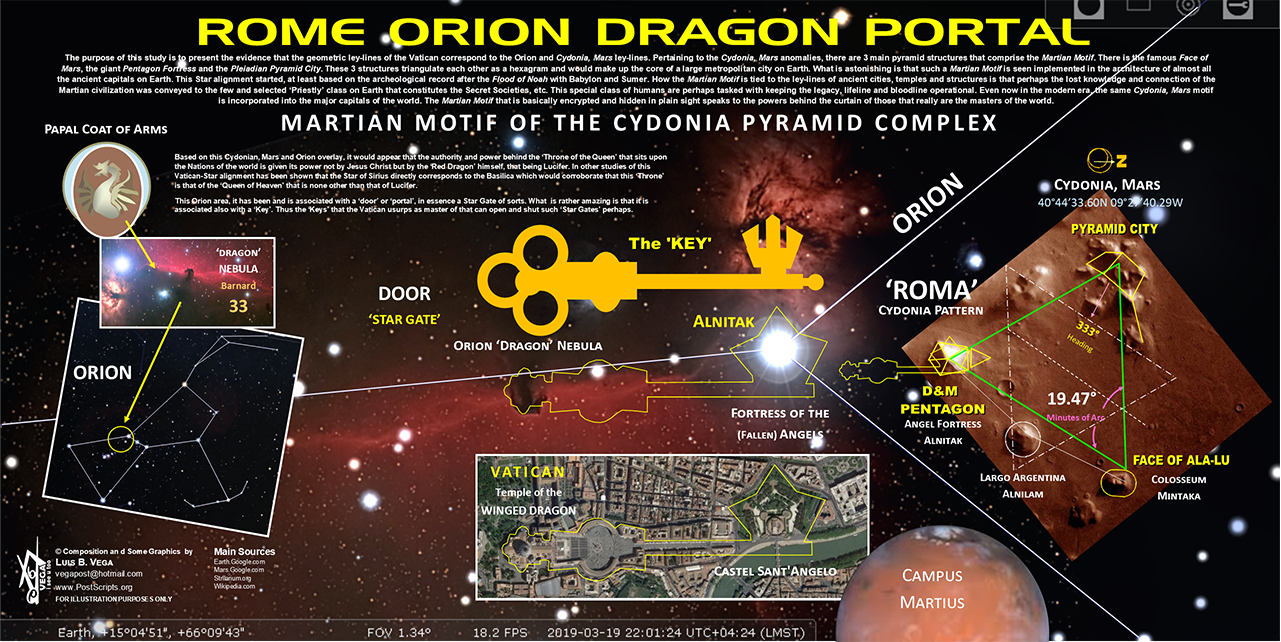
ANCIENT EGYPTIAN GEODESY - PART II
The great circle alignment from Giza to Alexandria has an azimuth of 51.85° north of due west from Giza (the same angle as the slope of the Great Pyramid). Extended beyond Alexandria, this great circle also crosses over Delphi, Rollright and Newgrange, as well as the city of London.
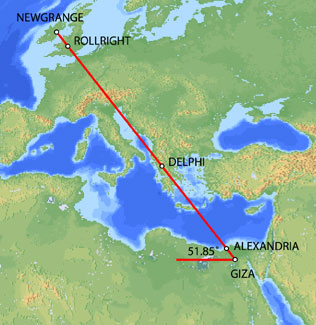
Map image © VectorGlobe
The azimuth of a great circle alignment from Dendera to Paris is also 51.85° north of due west.
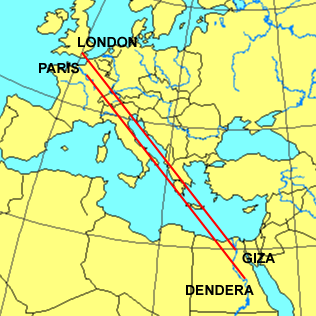
Map image - Roger Hedin
Dendera was dedicated to Isis/Sirius. The ancient Egyptian year began on the date of the heliacal rising of Sirius in mid July. The helical rising of Sirius heralded the annual inundation of the Nile that was essential to the welfare of ancient Egypt. The axis of the temple of Isis at Dendera was aligned 20° south of due east, pointing directly at the rising point of Sirius from the latitude of Dendera.
Robert Bauval describes a number of connections between Isis/Sirius and Paris in Talisman (2004). Isis is shown riding on a boat in many ancient Egyptian drawings and carvings. At the direction of Napoleon, Sirius and a statue of Isis were added to the coat of arms for Paris shown below.
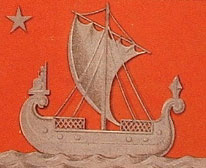
During the French revolution, a statue of Isis known as the Fountain of Regeneration was constructed on the former site of the Bastille. The engraving below commemorated this statue.
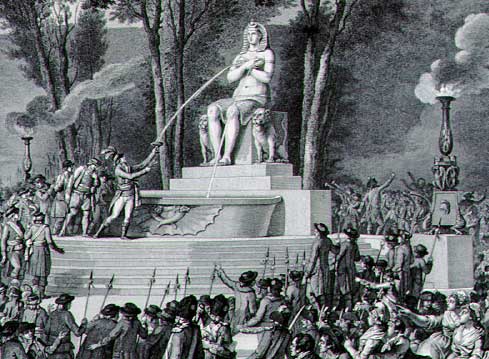
Fountain of Regeneration Engraving
The Elysian Fields is described as a place of eternal salvation in the ancient Egyptian Book of the Dead. Named after the Elysian Fields, the Champs Elysees is the main axis of Paris. The names Elysian and Elysees both suggest an association with Isis. The photograph below is facing southeast. The Arc de Triumphe is visible in the background. Beyond the Arc de Triumphe is the Louvre. The azimuth of the Champs Elysees is 26° south of due east, pointing directly at the rising point of Sirius/Isis from the latitude of Paris.

The termination point of the Champs Elysees to the northwest is the Grande Arche, in the foreground of the picture above. The axis of the Grande Arche is offset 6.33° south of the axis of the Champs Elysees. With an azimuth of just over 32° south of due east, the azimuth of the axis of the Grande Arche is the same as the azimuth of the great circle alignment from Paris to Dendera.
The Grande Arche is a nearly perfect cube with a height of 110 meters, a width of 108 meters and a depth of 112 meters. It is often described as a cube with side lengths of 110 meters. This is equal to 210 ancient Egyptian cubits:
110/210 = .5238
.5238 meters is a precise measure of the ancient Egyptian cubit, equating to 20.6222 inches, well within the ± .005 inches in Petrie's 20.62 inch measure of the ancient Egyptian cubit. Instead of the usual comparisons between the cubit and the meter of .52375/1 or .524/1, the best comparative measure may be the simple fraction of 11/21 that is suggested by the Grande Arche.

Image © Insecula.com
The sides of the Grande Arche are divided into 5 x 5 large panels and within each large panel are 7 x 7 smaller panels. Side lengths of 110 meters suggest lengths of 22 meters for the sides of the large panels with lengths of 22/7 meters for the sides of the smaller panels. The fraction 22/7 equals 3.1428, an accurate expression of π that is also found in the dimensions of the Great Pyramid. Side lengths of 210 cubits in the Grande Arche suggest lengths of 42 cubits for the sides of the large panels and 6 cubits for the sides of the smaller panels. This also shows that the relationship between the meter and the cubit is 6/π, using the measure of 22/7 for π:
21/11 = 6/π
22/7 x 21/11 = 6
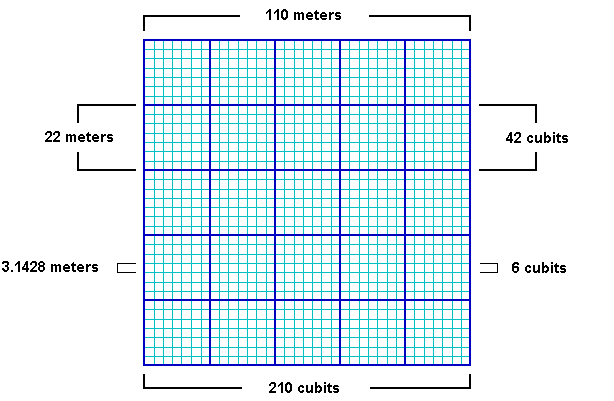
The northern pyramid at Dashur, known as the Red Pyramid, was the first true (smooth sided) pyramid built in Egypt and it was the last pyramid built prior to construction of the Great Pyramid. The baselengths of the Red Pyramid are 420 cubits (220 meters) long, 20x multiples of 21/11.
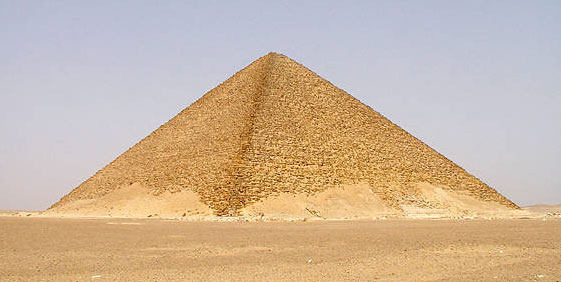
Image by Jon Bodsworth
One of the oldest stone circles in England is at Rollright. The diameter of the Rollright circle is 31.4 meters, an accurate expression of π times 10 meters. Given the 6/π relationship between the meter and the cubit, the diameter of the Rollright circle is also 60 ancient Egyptian cubits.

BACK
http://home.hiwaay.net/~jalison/Art5.html
|
|
|
|
|
Dog Days Prophecy
Sirius, Regulus, Super Bowl, financial crises, earthquakes & August 2015 Lucifer time codes
By Goro
August 02, 2015
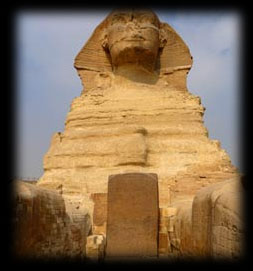
[Great Sphinx aka "Father of Terror"]
[NOTE: Yes, the global stock market chaos of August 2015 was predicted with precision in this article (posted on Aug 2, 2015) as you'll see below or in the new article When Prediction Comes True.... If you're new here, this is not a fluke as this is what I do on my websites (Etemenanki & STRUG). You may find the approach baffling, but you can't argue with this kind of unambiguous results. Key parts of this information was originally posted all the way back in February on STRUG (members only).]
Terror was the opening music for the year 2015, potentially foreshadowing what may transpire in August...

Our job here is to discern and decode a set of "time codes" lurking just below the surface of reality which in this case is celestially anchored by two stars: Sirius and Regulus.
Sirius is the star of Isis per ancient Egyptian tradition, and Paris ("Par-Isis") is semi-officially a city of Isis-Sirius where we find the Historical Axis (including the world-famous Champs Elysees boulevard) oriented toward the daily rising of Sirius.
The same axis happens to align with the sunset on August 6–8...

…as well as May 4–5 which this year gave us highly meaningful events already:


The Historical Axis also aligns with sunrise around February 1 (& Nov 9–11). This one coincided with the Super Bowl where Katy Perry did her halftime show in Phoenix this year.

On STRUG ("Super Torch Ritual Underground" members/underground area) I noted back in February that University of Phoenix Stadium (Super Bowl 2015) has some serious Sirius alignments...


...plus the fact that at the latitude of Phoenix (~33.45 N) the heliacal rising of Sirius takes place around August 7th, precisely coinciding with the Paris axis-sunset alignment day.

(The heliacal rising of Sirius is the "rebirth" of the star at dawn right before sunrise after a prolonged period of invisibility in the glare of the Sun; in ancient Egypt this was of great importance as it was for a period of time a signal for the life-giving annual flooding of the Nile, and also due to the general importance of the star and the goddess it represents, Isis.)
On the same day (~August 7, 2015) we'll even see a tight gathering of Jupiter, Mercury and Regulus at the "heart" of the lion (Leo)...
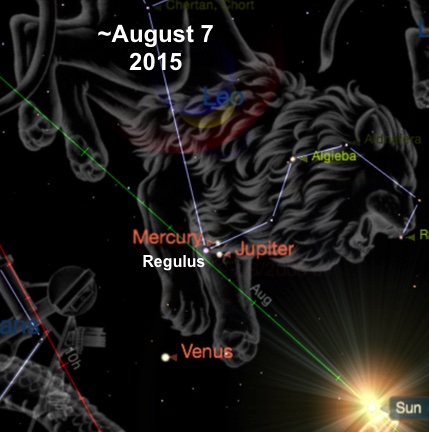
...bringing to mind the fact that Katy Perry spends most of her time at the heart/Regulus position between the paws of the Sphinx (lion/Leo) in her 2014 music video for Dark Horse…

…something evoked during the opening scene of Katy's 2015 Super Bowl halftime show (riding a giant lion).

Regulus is one of the brightest stars in the night sky, which is not only the "heart of the lion" but also "prince" (or "little king") as well as "the King", just as Jupiter is named after the king of the gods. It is highly significant therefore that Regulus and Jupiter will be in "royal" conjunction on ~August 11.
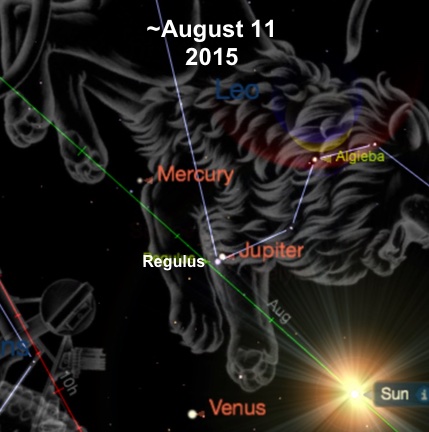
Remarkably ~August 11, 2015 is also pinpointed by a "Mayan financial crisis" time code I started highlighting back in February (STRUG) which is based on the Golden Ratio ("phi") and at least three major dates/events: 1) Transit of Venus (2004), 2) the day the US financial system almost came crashing down (9/14/2008), and 3) the "end" of the Mayan calendar (12/21/2012):
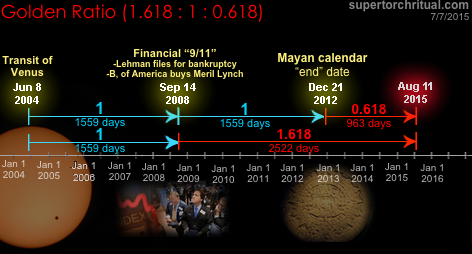

[Transit of Venus - June 8, 2004 & June 6, 2012 -
rare phenomenon of Venus passing in front of the Sun]
 Sep 14, 2008 Lehman Files for Bankruptcy; Merrill Is Sold Sep 14, 2008 Lehman Files for Bankruptcy; Merrill Is Sold
Sep 15, 2008 Crisis on Wall Street as Lehman Totters, Merrill Is Sold, AIG Seeks to Raise Cash
[Wikipedia - Global financial crisis in September 2008]
["Inside the Meltdown" (PBS) video]
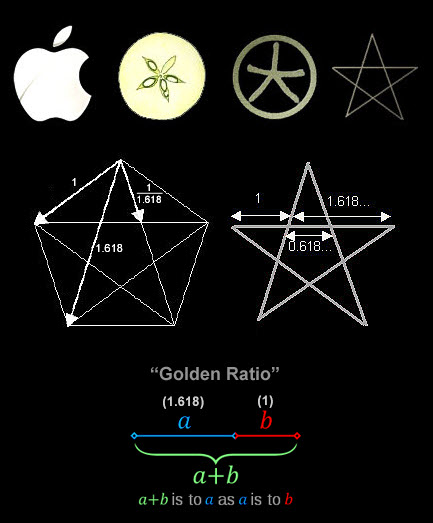
https://www.goroadachi.com/etemenanki/dogdays_prophecy.html |
|
|
|
|
ISLA SAN GIORGIO (VENECIA)=GEORGE LEMAITRE
|
|
|
 Primer Primer
 Anterior
492 a 506 de 506
Siguiente Anterior
492 a 506 de 506
Siguiente
 Último
Último

|

